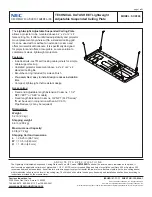
Page 41
Operation
optoNCDT 1320
3
The video curves to be displayed while or after measurement can be switched on or off in addition in
the left window. Non active curves are highlighted in gray and can be added by clicking the hook. If you
only want to see a single signal, then click on its name.
- Raw signal (uncorrected CMOS signal, red)
- Peak marking (vertical blue line), corresponds to the calculated measurement value
- Linearized measuring range (limited by means of gray shading), cannot be changed
4
For scaling the measurement value axis (y-axis) of the graphics you can either choose
Auto
(= auto
scaling) or
Manual
(= manual setting).
5
The search function enables time-saving access to functions and parameters.
i
ASCII commands to the sensor can also be sent via the search function.
6
In the text boxes above the graphics current values for distance, exposure time, current measuring and
display rate and timestamp are displayed.
7
Choice of a diagram type. In the setting
Auto
the diagram type matching the setting is chosen auto-
matically.
8
Mouse over function. When moving the mouse over the graphic in stopped state curve points are
marked with a circle symbol and the related intensity is displayed. The related x position in % appears
above the graphic filed
.
9
The linearized range is between the gray shading in the diagram and cannot be changed.
Only peaks
which centers are within this range can be calculated as measurement value. The masked range can be
limited on request and is additionally limited by means of a light blue shading on the right and on the
left. The remaining peaks in the resulting range are used for evaluation.
By displaying the video signal, you can detect effect of the adjustable measurement task (target material),
choice of peak and possible interfering signals by means of reflections.
There is no linear relationship between the position of the peaks in the video signal and the output measure-
ment value.
















































